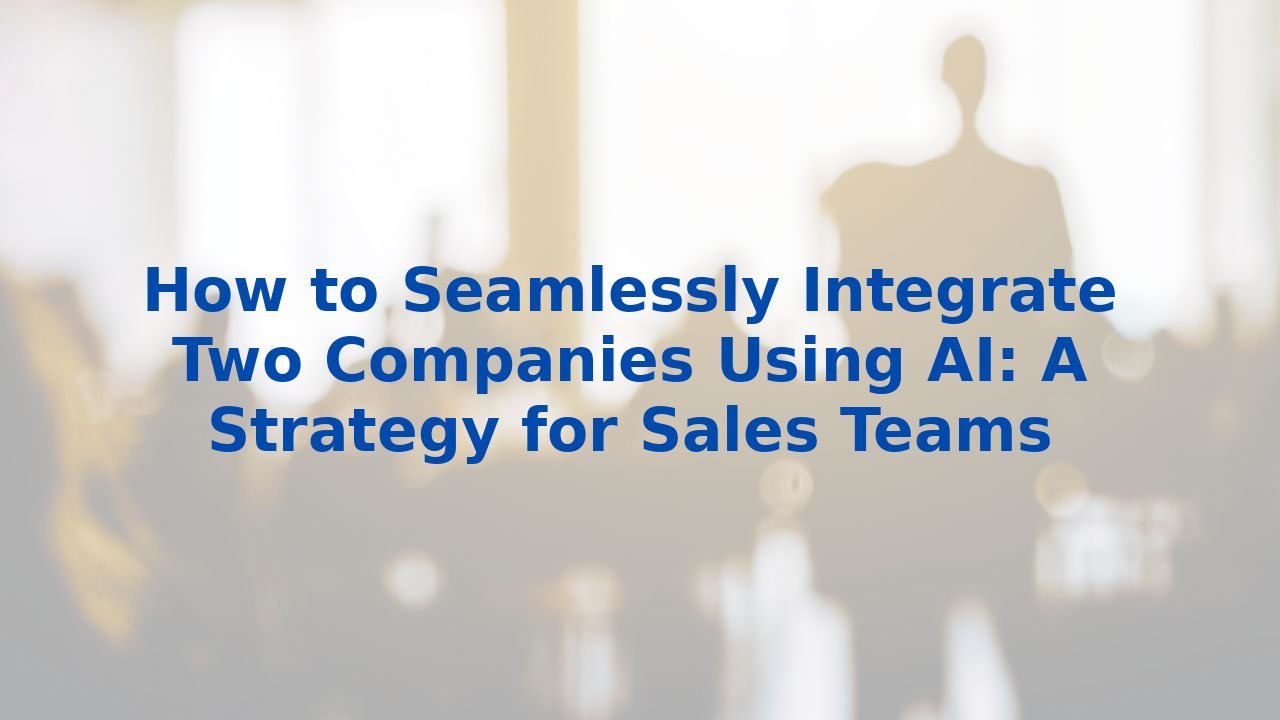How to Seamlessly Integrate Two Companies Using AI: A Strategy for Sales Teams
How to Seamlessly Integrate Two Companies Using AI: A Strategy for Sales Teams
Introduction
Integrating two companies into a cohesive unit is no small feat, especially for sales teams tasked with navigating the turbulence that can arise during mergers. The complexities involved can quickly become overwhelming. Yet, amid these challenges lies a transformative opportunity: artificial intelligence (AI). This post will delve into the immense potential AI holds for enhancing business processes and improving efficiency during corporate integrations.
Understanding AI Integration
AI integration refers to the process of embedding artificial intelligence technologies within existing business operations. The aim is clear: automating repetitive tasks, enhancing decision-making, and ultimately driving both efficiency and effectiveness. By leveraging AI, companies can streamline operations across various domains—ranging from customer service to supply chain management—reducing manual errors and elevating productivity.
Key Steps in Integrating AI
Before embarking on this journey, it’s important to follow a systematic approach: 1. Identify Areas for AI Value Start by pinpointing where AI can unleash significant value. Examine current business processes for tasks that are repetitive, time-consuming, or error-prone. 2. Select the Right AI Tools Once potential areas of improvement have been identified, carefully choose AI tools that align with your business needs. This is more than a simple selection; it requires a strategic assessment to ensure your chosen technologies integrate seamlessly with your goals. 3. Integrate AI Solutions Integrating AI requires harmonizing new systems with existing infrastructure. Ensuring compatibility will allow for smooth data flows and enhance user experience across the organization. 4. Train Staff Training is essential in this equation. Staff must be well-equipped to manage and utilize AI technologies effectively. Understanding how to work with AI tools and interpret insights is key to maximizing potential. 5. Monitor and Evaluate Performance Finally, consistent monitoring and evaluation are necessary to ensure that AI applications are performing as intended. Adopting an agile approach will allow for timely adjustments, keeping operations aligned and efficient.
Benefits of AI Integration
Integrating AI into your organization brings significant advantages: 1. Automated Operations One of the foremost benefits lies in automation. AI can take over mundane tasks—like data entry and attendance tracking—freeing human employees to focus on more strategic initiatives. 2. Improved Efficiency Expect to see a notable increase in efficiency—20-30% operational gains are not unheard of. Streamlining processes through automation leads directly to enhanced productivity and revenue growth across departments. 3. Enhanced Customer Experience The impact of AI extends to customer interactions as well. Personalized solutions and improved customer service can be delivered through AI-powered tools, such as chatbots that engage with clients 24/7. This not only enhances satisfaction but also allows customer service teams to focus on high-level concerns. 4. Data-Driven Insights AI systems produce valuable insights by analyzing historical data. Employing machine learning algorithms, businesses can uncover patterns that inform strategic decisions, paving the way for more effective planning. 5. Risk Prediction and Mitigation Moreover, AI's ability to analyze data for risk prediction helps identify potential bottlenecks, addressing issues before they escalate—essential for maintaining seamless operations through any transition.
Benefits of Training Employees for AI
As we consider the transformative potential of AI, the importance of training employees cannot be overstated. 1. Improved Understanding Training equips staff with the skills needed to manage AI tools effectively. A deeper understanding fosters confidence in interpreting insights, enhancing overall performance. 2. Enhanced Productivity When employees are well-trained, they can leverage AI tools to their fullest. This not only automates routine tasks but also allows them to engage in higher-level activities that promote growth. 3. Better Decision-Making Training programs empower employees to utilize AI-driven insights for better decision-making. This fosters a culture of strategic thinking, ensuring that decisions are not merely reactive but informed and proactive.
Conclusion
Integrating AI into business operations is more than just a technological upgrade; it's a strategy that fosters operational efficiency and informs better decision-making. From identifying areas for AI value to selecting the right solutions, training staff, and continuously monitoring performance, a structured approach is key to a successful integration. The benefits of AI are clear: automated operations, improved efficiency, enhanced customer engagement, and cost-effective risk management. But to truly reap these rewards, training employees in AI application is essential. As two companies come together, embracing AI with a focus on skill development will ensure a seamless transition, ultimately allowing the new entity to thrive in an increasingly competitive landscape.



